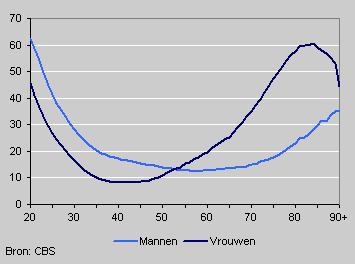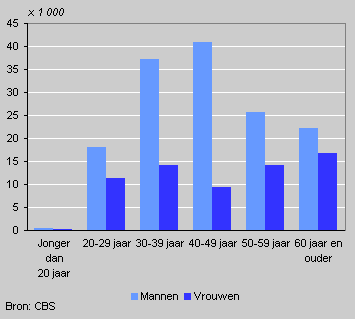Seven million households

The number of households in the Netherlands has reached 7 million. Over a third of these households consists of singles. Almost one third consists of multi-person households without children, often couples, married or otherwise. And again over one third consists of households with children.
The number of households has increased by half a million since 1995.
Increase in the number of households between 1 January 1995 and 1 January 2003

Substantial increase in the number of singles
Over half of the growth rate in the number of households is due to the increase in the number of singles. The group increased by 300 thousand since 1995, reaching 2.4 million households in 2003.
There was also a strong increase in the number of couples without children. The number of single-parent families went up as well. On the other hand, the number of couples with children decreased slightly.
Living on your own
About 15 percent of the Dutch population is single. There are three main groups of singles. The first group consists of young people who live by themselves for a while after leaving their parents’ house. About half of all 20 to 25 year old men live by themselves, and over 40 percent of all women in this age bracket.
Singles share, 1 January 2003

Dissolving relationships
There is a rapidly increasing group of people living alone temporarily after ending their relationship. About 15 percent of all men in their forties lives alone in 2003. The percentage of single women in this age bracket is considerably lower, because children often live with their mothers after a divorce.
Widows
The third group consists of women who were widowed at a relatively advanced age. Because the life expectancy of women is five years more than for men, and because most women marry a man who is about two years older, there are more widowed women than men. Over half the women aged over 75 live alone.
Growth mainly due to dissolving relationships
Between 1995 and 2003 the number of singles increased by 300 thousand. A third of this increase is due to population growth and changes in the age structure of the population.
Two thirds of the increase is due to the growing percentage of singles. Two thirds of the 200 thousand singles are men. There was a substantial increase in the number of single men aged between 30 and 50. The increase is mainly due to break-ups.
Increase in the number of singles between 1 January 1995 and 1 January 2003 (excluding the effects of age structure)

The number of older singles is also growing. They are not moving to old age homes to the same extent. There is only limited growth in the number of singles in there twenties.
Carel Harmsen and Liesbeth Steenhof
Source: StatLine